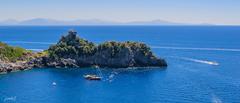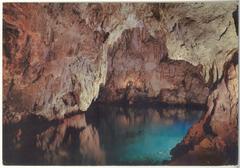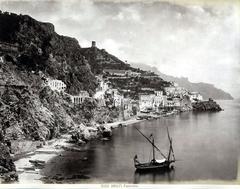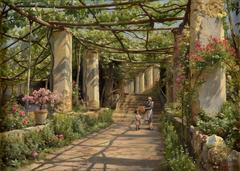
Sant’Andrea Fountain Amalfi: Visiting Hours, Tickets, and Travel Guide
Date: 03/07/2025
Introduction
Nestled in the bustling Piazza Duomo, the Sant’Andrea Fountain (Fontana di Sant’Andrea) is an iconic Baroque monument and a symbol of Amalfi’s spiritual, artistic, and maritime heritage. Built in 1760 from Carrara marble, the fountain features the statue of Saint Andrew, the town’s patron saint, surrounded by angelic figures and maritime motifs that reflect Amalfi’s rich history as a medieval maritime republic. Its central location, directly in front of the Amalfi Cathedral, makes it both a social gathering point and a focal site during religious festivals, especially on Saint Andrew’s feast days.
This detailed guide covers everything you need to know: visiting hours, ticketing, accessibility, artistic and historical significance, travel tips, and nearby attractions. Whether you are an art lover, history enthusiast, or simply soaking in the Amalfi Coast’s charm, the Sant’Andrea Fountain is a must-see landmark.
For up-to-date resources, visit the Official Amalfi Tourism Website and the Amalfi Cathedral Official Site.
Table of Contents
- Historical Origins and Construction
- Artistic Features and Symbolism
- Religious Significance and Connection to Amalfi Cathedral
- Visiting Hours, Tickets, and Accessibility
- Travel Tips and Nearby Attractions
- Restoration and Preservation
- Role in Urban Life and Local Traditions
- Frequently Asked Questions (FAQ)
- Visitor Tips and Practical Advice
- Conclusion
- External Resources & References
Historical Origins and Construction
The Sant’Andrea Fountain was erected in 1760 as part of a larger initiative to beautify public spaces in Amalfi and provide both a functional water source and an artistic landmark (Travel Amalfi Coast). Initially positioned at the base of the cathedral staircase, the fountain was relocated to the center of Piazza Duomo in the late 19th century to improve accessibility and enhance the grandeur of the square.
Artistic Features and Symbolism
This Baroque masterpiece is carved from white Carrara marble. Its centerpiece is a statue of Saint Andrew holding the cross of his martyrdom, surrounded by four angels symbolizing divine protection. The fountain basin is adorned with rich iconography: a dove representing the Holy Spirit, a mermaid and satyr reflecting mythological and maritime themes, and additional figures such as “Pulicano,” a sea deity, and an eagle. These details celebrate Amalfi’s seafaring legacy and its artistic connections to Byzantine and Arab-Norman traditions (Travel Amalfi Coast, Italia.it).
Religious Significance and Connection to Amalfi Cathedral
The fountain’s dedication to Saint Andrew is closely linked to the adjacent Amalfi Cathedral, which houses the saint’s relics and has been a pilgrimage site since the 13th century (Italien Expert). During the annual Feast of Saint Andrew (June 27 and November 30), the fountain becomes a vibrant centerpiece for religious processions and community celebrations, underlining its importance in both sacred and civic life (Rove.me).
Visiting Hours, Tickets, and Accessibility
- Visiting Hours: The fountain and Piazza Duomo are open to the public 24/7, with water features operating during daylight hours.
- Entrance Fees: There is no ticket required to visit the fountain. The adjacent cathedral and cloister have their own hours and entrance fees.
- Accessibility: The piazza is level and wheelchair-accessible, with paved surfaces and ramps near the cathedral. Some areas have cobblestones, so visitors with mobility challenges may require assistance.
Travel Tips and Nearby Attractions
- Best Times to Visit: Early mornings or late afternoons offer the best lighting for photography and lighter crowds.
- Nearby Sights:
- Amalfi Cathedral (Duomo di Sant’Andrea): Houses Saint Andrew’s relics and offers access to the Cloister of Paradise and crypt.
- Museo della Carta (Paper Museum): Highlights Amalfi’s renowned paper-making tradition.
- Cafés and Shops: Piazza Duomo is lined with eateries, gelaterias, and artisan boutiques.
- Getting There: The fountain is a 5-minute walk from Amalfi’s main bus terminal and harbor. Ample signage guides visitors through the historic center (Go Ask a Local).
Restoration and Preservation
Sant’Andrea Fountain underwent significant restoration in 2018, funded by tourist revenue, to clean and conserve the marble sculptures and inscriptions. These efforts ensure the monument’s continued beauty and structural integrity (Travel Amalfi Coast, Rehlat).
Role in Urban Life and Local Traditions
Historically, the fountain supplied fresh water and acted as a meeting place for locals. Today, it remains a lively social hub—hosting festivals, concerts, and gatherings. During the Feast of Saint Andrew, the fountain becomes the heart of religious and civic festivities (Evendo, Rove.me).
Tossing a coin into the fountain for good luck and to ensure a return visit remains a cherished tradition. The fountain also features artistic and civic inscriptions that celebrate Amalfi’s maritime and literary heritage (Travel Amalfi Coast, Visit Amalfi Info).
Frequently Asked Questions (FAQ)
Q: What are the visiting hours for Sant’Andrea Fountain?
A: The fountain and Piazza Duomo are accessible 24/7.
Q: Is there a fee to visit the fountain?
A: No, the fountain is a public monument and free to visit.
Q: Is the fountain wheelchair accessible?
A: Yes, the piazza is mostly flat and accessible, though some cobblestones may be challenging.
Q: Are guided tours available?
A: Yes, many historical tours of Amalfi include the fountain as a highlight.
Q: Can I drink water from the fountain?
A: The fountain is decorative and not intended for drinking.
Q: When is the best time for photography?
A: Early morning and late afternoon offer the best light and fewer crowds.
Visitor Tips and Practical Advice
- Dress Code: Modest attire is recommended, especially if visiting the cathedral.
- Photography: For the best photos, stand across the piazza or on the cathedral steps. Early or late hours provide optimal lighting.
- Local Events: The Feast of Saint Andrew on June 27 and November 30 features processions and festivities centered around the fountain (Lonely Planet).
- Safety: Amalfi is generally safe, but be mindful of belongings during crowded events.
- Amenities: Cafés, ATMs, and public restrooms are located nearby. Many cafés offer outdoor seating with views of the fountain.
Conclusion
The Sant’Andrea Fountain stands as a testament to Amalfi’s enduring spirit—blending Baroque artistry, religious devotion, and vibrant community life in one of Italy’s most picturesque settings. Its freely accessible location in Piazza Duomo ensures that every visitor can experience its beauty, history, and cultural significance. For a richer Amalfi experience, combine your visit with nearby sites, enjoy local cuisine, and participate in traditional festivities.
Download the Audiala app for interactive maps, audio guides, and the latest event information. Stay connected with Amalfi’s living heritage and make the Sant’Andrea Fountain a highlight of your Italian coastal journey.
External Resources & References
- Travel Amalfi Coast
- Italien Expert
- Azienda Turismo Positano
- Visit Amalfi Info
- Rove.me
- Evendo
- Amalfi Coast Official Tourism
- Amalfi Cathedral Official
- Lonely Planet
- Go Ask a Local
- Mamalovesitaly
- Holidify
- Rick Steves Amalfi
- Sacred Destinations
- Instagram Amalfi






